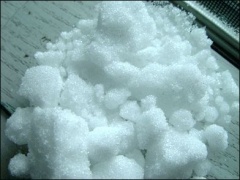Difference between revisions of "Camphor"
m (→Risk factors) |
|||
| (7 intermediate revisions by 2 users not shown) | |||
| Line 7: | Line 7: | ||
| risk factors = See text | | risk factors = See text | ||
}} | }} | ||
| + | __TOC__ | ||
| + | ==Description== | ||
| + | Colorless or white (translucent) crystals, granules or easily broken masses; penetrating aromatic odor, sublimes slowly at room temperature, slightly soluble in water, soluble in alcohol, [[ether]], [[chloroform]], carbon disulofide, solvent naphta and fixed volatile oils.<br><br> | ||
| + | Derivation is steam distillation of the camphor-tree wood and crystallization. This product is called natural camphor, most of which is optically inactive, may be made from pinene, which is converted into camphene which by treatment with [[Acetic Acid]] and nitrobenzene becomes camphor, turpentine oil is also used. <br><br> | ||
| + | A liquid form (camphor oil) is produced almost exclusively in Taiwan; formerly used in the manufacture of [[Sassafras Oil]]; the available supply is used chiefly as a fragrance or flavouring material and to some extent as a pharmaceutical product.<br><br> | ||
| + | |||
| + | ==Applications== | ||
| + | Medicine (internal and external), plasticizer for cellulose nitrate, other [[explosives]] and lacquers, insecticides, moth and mildew proofings, tooth powders, flavouring, embalming, pyrotechnics, intermediate.<br><br> | ||
| + | ==Shipment / Storage== | ||
| + | Shipped in lined cases.<br><br> | ||
| + | When heated evolves inflammable and explosive gases. Slowly volatilizes at ordinary temperatures. Cases should be weighed to ascertain loss due to evaporation.<br><br> | ||
| + | Keep container in a cool, well-ventilated area. Keep container tightly closed and sealed until ready for use. Avoid all possible sources of ignition (spark or flame). Do not store above 23°C (73.4°F).<br><br> | ||
| + | |||
| + | ==Risk factors== | ||
| + | Evolves flammable and explosive vapors when heated.<br><br> | ||
| + | Keep away from heat. Keep away from sources of ignition. Ground all equipment containing material. Do not ingest. Do not breathe dust. Wear suitable protective clothing. In case of insufficient ventilation, wear suitable respiratory equipment. If ingested, seek medical advice immediately and show the container or the label. Avoid contact with skin and eyes.<br><br> | ||
| + | Consult applicable MSDS sheet(s).<br><br> | ||
| + | Reference is also made to the relevant IMO regulations on hazardous cargo.<br><br> | ||
| − | + | See also: http://www.chemicalland21.com/lifescience/phar/CAMPHOR,%20SYNTHETIC.htm<br><br> | |
| − | |||
| − | |||
| − | |||
| − | |||
| − | |||
| − | <br | ||
| − | |||
| − | |||
[[Category:Products]] | [[Category:Products]] | ||
| + | [[Category:Miscellaneous]] | ||
Latest revision as of 12:07, 12 January 2021
| Infobox on Camphor | |
|---|---|
| Example of Camphor |  |
| Facts | |
| Origin |
|
| Stowage factor (in m3/t) | 1,30 / 1,90 m3 /t (cases) |
| Humidity / moisture | - |
| Ventilation | - |
| Risk factors | See text |
Camphor
Description
Colorless or white (translucent) crystals, granules or easily broken masses; penetrating aromatic odor, sublimes slowly at room temperature, slightly soluble in water, soluble in alcohol, ether, chloroform, carbon disulofide, solvent naphta and fixed volatile oils.
Derivation is steam distillation of the camphor-tree wood and crystallization. This product is called natural camphor, most of which is optically inactive, may be made from pinene, which is converted into camphene which by treatment with Acetic Acid and nitrobenzene becomes camphor, turpentine oil is also used.
A liquid form (camphor oil) is produced almost exclusively in Taiwan; formerly used in the manufacture of Sassafras Oil; the available supply is used chiefly as a fragrance or flavouring material and to some extent as a pharmaceutical product.
Applications
Medicine (internal and external), plasticizer for cellulose nitrate, other explosives and lacquers, insecticides, moth and mildew proofings, tooth powders, flavouring, embalming, pyrotechnics, intermediate.
Shipment / Storage
Shipped in lined cases.
When heated evolves inflammable and explosive gases. Slowly volatilizes at ordinary temperatures. Cases should be weighed to ascertain loss due to evaporation.
Keep container in a cool, well-ventilated area. Keep container tightly closed and sealed until ready for use. Avoid all possible sources of ignition (spark or flame). Do not store above 23°C (73.4°F).
Risk factors
Evolves flammable and explosive vapors when heated.
Keep away from heat. Keep away from sources of ignition. Ground all equipment containing material. Do not ingest. Do not breathe dust. Wear suitable protective clothing. In case of insufficient ventilation, wear suitable respiratory equipment. If ingested, seek medical advice immediately and show the container or the label. Avoid contact with skin and eyes.
Consult applicable MSDS sheet(s).
Reference is also made to the relevant IMO regulations on hazardous cargo.
See also: http://www.chemicalland21.com/lifescience/phar/CAMPHOR,%20SYNTHETIC.htm











